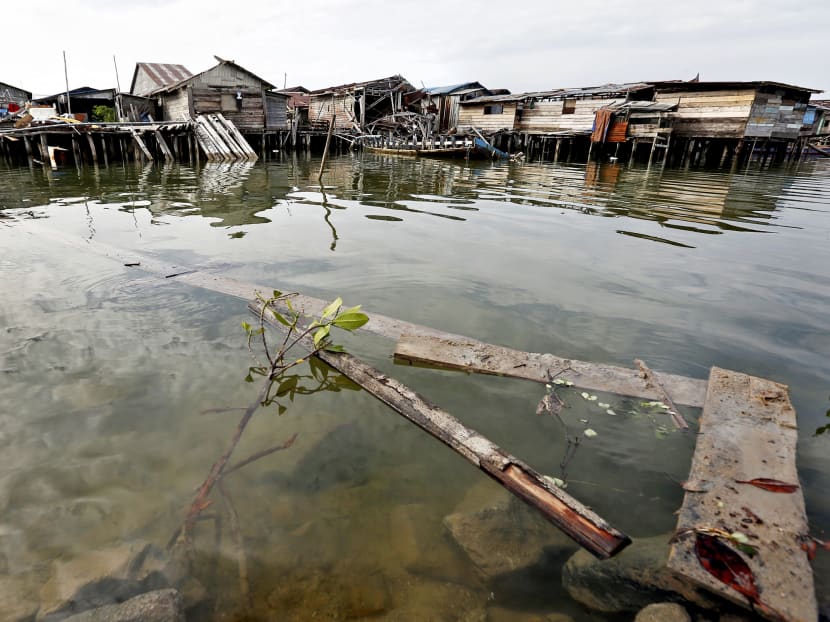Indonesia lures investors with island-naming rights
JAKARTA — Investors in Indonesia’s remote islands will soon be able to leave their mark on the map — literally.

In this picture taken July 10, 2014 is a collapsed walkway floats in the water next to Penagi, an ethnic Chinese village built on stilts, on Natuna Besar, one of the islands that Japanese investors have expressed interest in. Photo: Reuters
JAKARTA — Investors in Indonesia’s remote islands will soon be able to leave their mark on the map — literally.
Those willing to develop the islands — thousands of which remain officially unnamed — will get naming rights in return.
“This is just one of the many ways in our strategy to lure investors here,” said Mr Ridwan Djamaluddin, a deputy minister for infrastructure at the Coordinating Ministry for Maritime Affairs. “This could be an incentive for them.”
The names will have to go through an approval process, he added.
The Coordinating Minister for Maritime Affairs, Mr Luhut Binsar Pandjaitan, told a news conference on Jan 9 that the country still had 4,000 islands with no names. The Indonesian archipelago has 17,508 islands and stretches roughly 5,000km from west to east across the equator, with a total land area of 1.9 million sq km.
Should there be any foreign investors interested in turning an island into a tourism destination, Mr Pandjaitan said, they would be allowed to name the island. A Japanese investor, for example, could name an island Yokohama, but it would still be under Indonesian sovereignty, he stressed.
Turning some islands into tourist destinations, he said, would be a quick way to create job opportunities for local residents, stimulate the economy, and increase tax revenues.
Data from the Investment Coordinating Board showed that in 2014, total investment in tourism was US$684.9 million (S$971.7 million), of which US$511.8 million was foreign investments.
The Tourism Ministry has set a target for the sector to contribute 9.2 per cent to the gross domestic product (GDP) by 2019, compared with about 4 per cent in 2014. The goal is to attract 20 million foreign tourist arrivals and generate US$20 billion in revenue, compared with US$10.7 billion in 2014.
Mr Damos Dumoli Agusman, the secretary of the directorate-general for legal affairs and international treaties at the Foreign Ministry, said that approval of any foreign investment to manage small islands and their surrounding waters should be in accordance with the 2014 law on coastal areas and small island management.
“In order to gain a permit to manage the island, the investor must ensure, among other things, that the island is uninhabited, ensure public access to the island, and (operate) in cooperation with an Indonesian partner,” he said.
Mr Ridwan said Japanese investors had already expressed interest in at least three islands, even though they have already been named: Morotai in north Maluku, which borders the Philippines; the Natuna Islands in the northern maritime frontier area bordering the South China Sea; and Sabang in Aceh.
“We offer them the historical ties that Japan has with Morotai, and by plane, it’s only a four-and-a-half-hour flight from Japan,” he said.
Morotai was a battleground when Japan fought the Allied forces during World War II, which ended with Japan’s surrender in September 1945. A Japanese soldier hid for 30 years in the island’s jungles until he was found in 1974.
Mr Arista Atmadjati, a tourism lecturer at Universitas Gadjah Mada in Yogyakarta, said there was potential for Indonesia to develop its uninhabited, remote or outermost islands into tourist destinations for a niche market.
“It would be no problem for tourists in this market to visit far-flung islands. There are already islands in Indonesia that serve such purposes, and they are well known among a very segmented group of foreign vacationers,” he said.
He said that promoting Morotai, with its historical connection to Japan, was a good example of a way to draw foreign tourist arrivals away from major destinations such as Bali, Yogyakarta or Lombok to other parts of the vast archipelago.
But he is not in favour of giving foreign investors the right to name an island. “It’s not as if we have run out of ideas to name our own islands. It should not be a difficult task for us to come up with our own names,” he said.
Maritime activist Armand Manila sees a broader threat to the country’s maritime identity beyond the mere matter of names.
“The privatisation or commercialisation of coastal areas could sink local residents into structural impoverishment,” said Mr Manila, who is the acting secretary-general of the People’s Coalition for Equal Fisheries (Kiara), a grouping of environmental and social groups. He said local residents had the traditional rights to passage in the waters off an island, fish in its surrounding maritime area, enjoy access to clean water, and benefit from the environment’s natural resources.
“They could lose these rights due to the commercialisation and privatisation of an island,” he said, adding that there are already examples of local people being barred from fishing in their traditional grounds because they lie within 1.5km of the coastline of a privately managed island.
“They are being evicted from their source of livelihood because they are considered to have the potential to destroy the maritime environment which serves as the island’s tourism attraction.”






